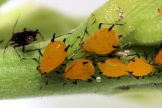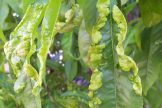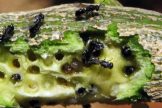
Phyllocnistis citrella
This is a small nocturnal moth which lays its eggs on the underside of soft fresh leaves of citrus. The eggs hatch and the larvae rapidly burrow under the surface of the leaf, and it is these larvae that cause all the damage. The larvae feed on the epidermal cells of the leaf, creating the typical silvery snake-like ‘mined’ damage to the leaf.
Controlling Citrus-leafminer
Pheromone Traps
Finally something that works! One of our wholesalers in Victoria used these last year with great success. Called the eco-CLM Trap, it is a sticky trap combined with a very strong pheromone lure which attracts the male citrus leafminer. The result is fewer females able to lay eggs and much greater protection for your trees. The lure remains effective for around 2-3 months, and you need 1 for a small tree, 2 for a large tree. As soon as the weather warms up, the leaf miners become active, so install sometime in spring – temperature depending. Keep an eye out after 12 weeks and if damage is occurring – you may need to install another one. The pheromone is specific to the male Citrus Leafminer, so does not attract any beneficial insects that may be around.
Chemical control
While very difficult to control with insecticides because they are protected by their leaf ‘mines’, they can be managed by both cultural means and predatory insects. If choosing to spray, the best spray to use for the home gardener is white oil. The moths avoid leaf surfaces sprayed with oil. Spray every 5-7 days in warm weather and spray both upper and lower sides of new growth (don’t wait for leaf to fully open, start spraying when still tiny). Spray to the point of run off: i.e. have a fine mist over the leaves, but if the spray starts dripping off the leaves you have sprayed too much and the effort is wasted. Because this is an oil water mix, continually shake or agitate the mixture to prevent it from separating. Do not spray when the soil is dry, as trees should not be suffering moisture stress when you spray, and avoid spraying when over 32ºC.
Spinosad (marketed as Success) is reputed to be effective against leaf-miners, particularly Tomato leaf-miner. Whether or not it is effective against Citrus Leafminer is not known yet.
Natural Enemies
Brown and Green Lacewings predate on Citrus Leafminer. Green Lacewings are available as a biological control. They are highly susceptible to pesticides, so do not release them for 4 weeks after residual pesticide use.
Cultural control
Citrus Leafminer is most active over summer and autumn and is restricted to soft new growth, so you need to adjust pruning and feeding regimes to get the soft new growth when the Citrus Leafminer is not active. Keep watering and fertilizing to the minimum required for the health of the tree for the rest of the year. Prune leaf flushes at other times of the year.




